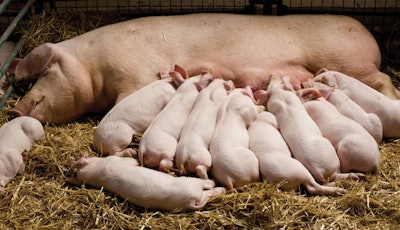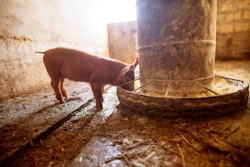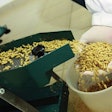
The effect of increased feed intake during lactation on litter growth is less well documented.
I was recently involved in a heated discussion with a pig producer regarding the real value of lactation feed. He was using a diluted feed by adding inexpensive byproducts, while I was advocating a more expensive but also more concentrated feed. The problem was low weaning weight and thin sows at weaning that were difficult to rebreed.
I had to remind him that feed intake of lactating sows should be maximized to enhance reproductive performance and litter growth. For each 10% of body fat sows lose during lactation, subsequent litter size is reduced by one piglet. Likewise, each kilogram of body weight sows lose during the previous lactation will result in an extra day until conception. The effect of increased feed intake during lactation on litter growth is less well documented, but it is of paramount importance in systems that place extra value on weaning weight.
Sow’s milk is a rich source of nutrients. It contains about 200 g/kg dry matter, 55 g/kg protein, 50 g/kg lactose, and 80 g/kg fat, on a liquid basis. Calculated metabolizable energy content is about 5.4 MJ/kg. Assuming that growth in suckling piglets requires approximately 22 MJ ME/kg weight gain, and the protein profile in sow’s milk is ideally balanced, it is estimated that piglets require about 4 kilograms of milk for each kilogram of body weight gain, based on energy calculations (22 / 5.4 ~ 4).
A typical lactation diet based on cereals and plant proteins contains about 14 MJ ME/kg. The marginal coefficient of converting feed energy to milk energy is about 70%. This implies that each kilogram of feed has the potential of yielding 9.8 MJ ME for milk production. If dietary protein quality and quantity does not restrict milk production, a sow should produce approximately 2 kilograms of milk (9.8 / 5.4 ~ 2) per kilogram of feed consumed beyond maintenance needs. If feed or nutrient intake is restricted, then milk production and sow performance will be hindered.
In our case, sows consumed an average of 5 kg/day and we managed to increase this by 2 kg/day by removing voluminous fiber sources and adding more energy and protein. As expected, sows retained their body condition better, and piglet weight at weaning increased significantly. These 2 extra kg/day would have yielded 4 extra kilograms of milk, which would be converted to 1 kg/day weight gain in piglets. Assuming 25 days of lactation and 12 piglets per sow, this would be 25/12~2 kg/piglet extra weight at weaning. Because it is still winter, we have increased weaning weight by only 1.5 kilograms while retaining body condition in sows.


















